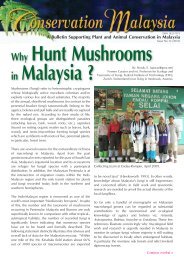No. 7/2008 - Tfbc.frim.gov.my - frim
No. 7/2008 - Tfbc.frim.gov.my - frim
No. 7/2008 - Tfbc.frim.gov.my - frim
You also want an ePaper? Increase the reach of your titles
YUMPU automatically turns print PDFs into web optimized ePapers that Google loves.
Continued from cover page<br />
A<br />
Ridleyandra atropurpurea (Gesneriaceae)<br />
is very rare, previously<br />
known from only two collections,<br />
the last made almost a hundred<br />
years ago. The species was poorly<br />
known with flower colour described<br />
simply as ‘deep purple’. Obviously<br />
the colour is not plain deep purple<br />
because the photograph shows the<br />
upper lobes are a rich shade of purple<br />
while the lower lobes have a fine<br />
white margin and conspicuous white<br />
lines running into the throat.<br />
Page 2<br />
B<br />
Photo credit: T.L.Yao<br />
Photo credit: K.Imin<br />
ENDEMIC AND RARE SPECIES<br />
C<br />
D<br />
Photo credit: T.L.Yao<br />
Begonia reginula (Begoniaceae) is<br />
a small rosette herb with attractive<br />
variegated foliage. Its habitat niche is<br />
very specific to vertical granite rocks<br />
close to small streams. The area<br />
where it was first discovered in Ulu<br />
Setiu, Terengganu has been clearfelled.<br />
The recent find in Taman Negara<br />
is indeed a relief.<br />
A, B. Trichosanthes quinquangulata<br />
C. Luvunga crassifolia<br />
D. Burkillanthus malaccensis<br />
The colour of the fruit and flesh of<br />
these rare species, Trichosanthes<br />
quinquangulata (Cucurbitaceae),<br />
Luvunga crassifolia (Rutaceae) and<br />
Burkillanthus malaccensis (Rutaceae)<br />
have never been recorded until<br />
now. Both L. crassifolia, an uncommon<br />
woody climber with a strong aromatic<br />
citrus smell, and B. malaccensis<br />
were collected for the first time for<br />
Taman Negara, Terengganu, while<br />
the unusual gourd, T. quinquangulata,<br />
from Cameron Highlands is the<br />
second record for this species from<br />
Peninsular Malaysia.<br />
Photo credit: T.L.Yao Photo credit: T.L.Yao<br />
It was the young fruits of Diospyros<br />
conformis (Ebenaceae) that attracted<br />
us to the tree, which turned out<br />
to be a hyper-endemic species that<br />
was only collected once before from<br />
the Lenggong area, Upper Perak,<br />
in 1925. The tree was growing on a<br />
gentle slope of an earth riverbank,<br />
its canopy spreading over the river<br />
from a crooked bole, reaching to<br />
about 20 m tall.<br />
Continue on page 7



